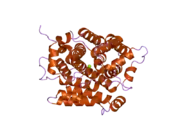ADPRHL2
Poly(ADP-ribose) glycohydrolase ARH3 is an enzyme that in humans is encoded by the ADPRHL2 gene.[4][5][6] This enzyme eliminates the proteins’ post-translational addition of poly-ADP ribose (PAR) in cellular stress. Loss-of-function mutations in the ADPRHL2 gene result in a recently defined disorder called stress-induced childhood-onset neurodegeneration with variable ataxia and seizures (CONDSIAS; OMIM: 618170) . The CONDSIAS is an autosomal recessive disorder which its pertinent gene (ADPRHL2) is mapped on chromosome 1p35.3-p34.1. The phenotypes of this disorder have been reported as neurodegeneration, variable ataxia and seizures, tremor, nystagmus, balance problems, cerebellar, spinal cord and cerebral atrophy, hearing impairment and occasionally hearing loss, ptosis, ophthalmoplegia, dysarthria, muscle weakness, axonal neuropathy, dysmetria, and tongue fasciculation. Symptoms and severity of the disorder appear to be different in patients and sometimes lead to early childhood death. In other words, although older patients present most of the above-mentioned symptoms, younger patients experience loss of developmental milestones and death in their early infancy.[7]
| ADPRS | |||||||||||||||||||||||||
|---|---|---|---|---|---|---|---|---|---|---|---|---|---|---|---|---|---|---|---|---|---|---|---|---|---|
 | |||||||||||||||||||||||||
| |||||||||||||||||||||||||
| Identifiers | |||||||||||||||||||||||||
| Aliases | ADPRS, ARH3, ADP-ribosylhydrolase like 2, CONDSIAS, ADP-ribosylserine hydrolase, ADPRHL2 | ||||||||||||||||||||||||
| External IDs | OMIM: 610624 MGI: 2140364 HomoloGene: 9863 GeneCards: ADPRS | ||||||||||||||||||||||||
| |||||||||||||||||||||||||
| |||||||||||||||||||||||||
| Orthologs | |||||||||||||||||||||||||
| Species | Human | Mouse | |||||||||||||||||||||||
| Entrez | |||||||||||||||||||||||||
| Ensembl | |||||||||||||||||||||||||
| UniProt | |||||||||||||||||||||||||
| RefSeq (mRNA) | |||||||||||||||||||||||||
| RefSeq (protein) | |||||||||||||||||||||||||
| Location (UCSC) | Chr 1: 36.09 – 36.09 Mb | n/a | |||||||||||||||||||||||
| PubMed search | [2] | [3] | |||||||||||||||||||||||
| Wikidata | |||||||||||||||||||||||||
| |||||||||||||||||||||||||
References
- GRCh38: Ensembl release 89: ENSG00000116863 - Ensembl, May 2017
- "Human PubMed Reference:". National Center for Biotechnology Information, U.S. National Library of Medicine.
- "Mouse PubMed Reference:". National Center for Biotechnology Information, U.S. National Library of Medicine.
- Glowacki G, Braren R, Firner K, Nissen M, Kühl M, Reche P, Bazan F, Cetkovic-Cvrlje M, Leiter E, Haag F, Koch-Nolte F (Jul 2002). "The family of toxin-related ecto-ADP-ribosyltransferases in humans and the mouse". Protein Science. 11 (7): 1657–1670. doi:10.1110/ps.0200602. PMC 2373659. PMID 12070318.
- Oka S, Kato J, Moss J (Jan 2006). "Identification and characterization of a mammalian 39-kDa poly(ADP-ribose) glycohydrolase". The Journal of Biological Chemistry. 281 (2): 705–713. doi:10.1074/jbc.M510290200. PMID 16278211.
- "Entrez Gene: ADPRHL2 ADP-ribosylhydrolase like 2".
- Aryan H, Razmara E, Farhud D, Zarif-Yeganeh M, Zokaei S, Hassani SA, Ashrafi MR, Garshasbi M, Tavasoli AR (August 2020). "Novel imaging and clinical phenotypes of CONDSIAS disorder caused by a homozygous frameshift variant of ADPRHL2: a case repor". BMC Neurology. 20 (1): 291. doi:10.1186/s12883-020-01873-3. PMC 7397971. PMID 32746785.
External links
- Human ADPRHL2 genome location and ADPRHL2 gene details page in the UCSC Genome Browser.
Further reading
- Maruyama K, Sugano S (Jan 1994). "Oligo-capping: a simple method to replace the cap structure of eukaryotic mRNAs with oligoribonucleotides". Gene. 138 (1–2): 171–174. doi:10.1016/0378-1119(94)90802-8. PMID 8125298.
- Suzuki Y, Yoshitomo-Nakagawa K, Maruyama K, Suyama A, Sugano S (Oct 1997). "Construction and characterization of a full length-enriched and a 5'-end-enriched cDNA library". Gene. 200 (1–2): 149–156. doi:10.1016/S0378-1119(97)00411-3. PMID 9373149.
- Kernstock S, Koch-Nolte F, Mueller-Dieckmann J, Weiss MS, Mueller-Dieckmann C (Mar 2006). "Cloning, expression, purification, crystallization and preliminary X-ray diffraction analysis of human ARH3, the first eukaryotic protein-ADP-ribosylhydrolase". Acta Crystallographica Section F. 62 (Pt 3): 224–227. doi:10.1107/S1744309106003435. PMC 2197168. PMID 16511307.
- Mueller-Dieckmann C, Kernstock S, Lisurek M, von Kries JP, Haag F, Weiss MS, Koch-Nolte F (Oct 2006). "The structure of human ADP-ribosylhydrolase 3 (ARH3) provides insights into the reversibility of protein ADP-ribosylation". Proceedings of the National Academy of Sciences of the United States of America. 103 (41): 15026–15031. Bibcode:2006PNAS..10315026M. doi:10.1073/pnas.0606762103. PMC 1622773. PMID 17015823.
- Ono T, Kasamatsu A, Oka S, Moss J (Nov 2006). "The 39-kDa poly(ADP-ribose) glycohydrolase ARH3 hydrolyzes O-acetyl-ADP-ribose, a product of the Sir2 family of acetyl-histone deacetylases". Proceedings of the National Academy of Sciences of the United States of America. 103 (45): 16687–16691. Bibcode:2006PNAS..10316687O. doi:10.1073/pnas.0607911103. PMC 1636516. PMID 17075046.




